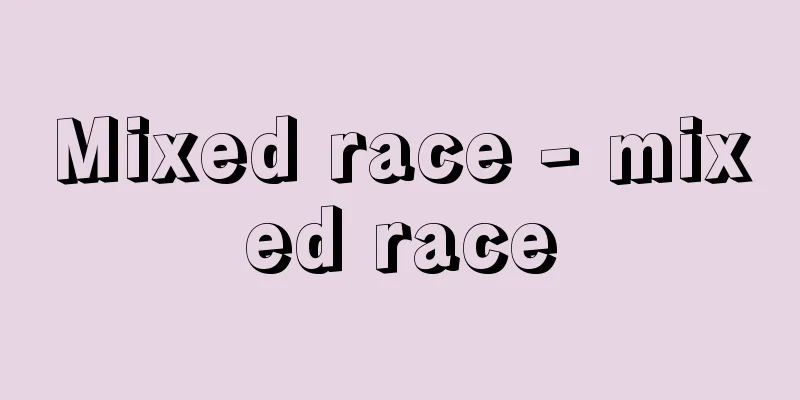Mixed race - mixed race

|
It is defined as "the birth of a child between people of different races, species, or ethnicities, or the child born between two people of different races, species, or ethnicities," but it is an ambiguous concept that combines biological meaning with social and cultural meaning. In Japanese, "konketsu" is used only for humans, and the term "hybrid" is used for other organisms, but in foreign languages, such as English, both are encompassed by the single term "hybrid." The term "mixed race" that we use in our daily lives is not necessarily based on biological grounds. However, things that do not actually have a biological basis or have not yet been clarified are sometimes spoken of as if they were scientific facts about mixed race. In order to understand the concept of mixed race, which continues to cause various problems in society in various places today, it is necessary to grasp its social and cultural meaning. Here, in order to avoid confusion, it is first necessary to consider the biological meaning of mixed race separately from other parts. [Hideo Kimura] Biological meaningThere are two types of hybrids: intraspecific hybrids (hybrids within the same species) and interspecific hybrids (hybrids between different species). However, since all modern humans belong to a single species, Homo sapiens, hybrids are equivalent to intraspecific hybrids. The biological concept of hybridization is based on the concept of race. Humans have a great diversity of physical traits. Even when it comes to skin color, there is a large range of variation between the whitest and blackest. Races are groups of people divided according to differences in various physical traits, including skin color, hair color and shape, and eye color. In recent years, detailed studies have been conducted on the genetic types of serum proteins and red blood cell enzymes in the blood, and it has become possible to express differences between groups numerically using the frequency of alleles. It may be said that the path to a more scientific classification is being opened compared to the traditional racial classification, which was based on easily visible physical traits such as skin color. However, there is still a big problem to be solved before a scientific racial classification can be established. This is because human traits are polymorphic, and individuals with a variety of different physical characteristics coexist within a single group. There are various theories about how many races humanity should be divided into, but no matter which classification you follow, when comparing two races for a certain physical trait, even if the average values are different, the range of variation overlaps, and when you look at a specific individual, it is difficult to determine which group they belong to. In other words, race is a concept that only has meaning when dividing human groups, and it must be said to be statistical and abstract rather than a practical classification of individuals. Unless this difficulty is resolved, it will be difficult to establish a scientific racial classification, and even though research on race is becoming more scientific with the development of molecular genetics, racial classification remains hypothetical, and some scholars question the concept of race itself. In relation to interracial mixing, there is no such thing as a "pure" race that has never had any genetic exchange with other groups, and from this point of view, one could say that all human beings are of interracial mixing. Furthermore, if race is a statistical and abstract concept, then interracial mixing is also a statistical and abstract concept, and it is biologically difficult to determine whether a specific individual is of interracial mixing or not. Mixed-race traits are often an intermediate between those of the parents, but which one is more strongly influenced varies depending on the trait and the individual, and examples include a child with mongoloid features and blonde hair, or a child with caucasian features and black hair, or siblings with completely different traits. Regarding the biological characteristics of hybrids, hybrid vigor, which is often discussed in plants and animals, is sometimes pointed out. Hybrid vigor is the phenomenon in which hybrids are superior to their parents in terms of disease and climate resistance and body size. Examples of hybrids are that they are larger than either parent, or that there are more beautiful people. However, it is impossible to judge whether a large body is in itself a good thing, and standards of beauty are cultural and subjective and cannot be scientifically judged. In addition, children of hybrids generally show a wider range of variation than either parent group, but some people believe that humans are adapted to their respective environments, and that hybridization reduces adaptability, while others believe that the wider range of variation that hybrids have increases their adaptability to the environment. In any case, it is not easy to decide whether a certain trait is adaptive or not, and it is even more difficult to deal with the issue of adaptation biologically when it comes to cultured humans. [Hideo Kimura] Social Recognition of Mixed RaceIn real life, the biggest criterion for determining whether or not someone is mixed race is social recognition. In other words, if a person is recognized as mixed race in a society, then that person is mixed race. For example, if a child is born to members of a group that is clearly distinguishable socially and culturally, such as a white person and an indigenous person, then the child is almost certainly considered to be mixed race. However, such facts cannot always be confirmed. Therefore, differences in physical characteristics and social and economic backgrounds are often used to determine whether or not someone is mixed race. However, differences in physical characteristics manifest themselves differently from person to person, and for example, even if there is a mixture of Negroid and Caucasian, it may be completely indistinguishable from Caucasian in appearance. Also, if several generations have passed since the mixture, it is impossible to strictly distinguish whether or not someone is mixed race. In the Republic of South Africa, where the distinction between white and mixed race (colored) was once important, a research book was published stating that many of the white people in the country are actually mixed race, causing a great stir over the validity of this statement. Social recognition of mixed race is ultimately based on the subjective judgment of the person making the recognition rather than on scientific evidence, and the distinction between mixed race and non-mixed race, precise classifications of mixed race, and even attitudes toward mixed race people vary greatly depending on the culture of the group. In white societies in North America and South Africa, people who looked indistinguishable from white people and lived the same lifestyle were treated as white, but when it was discovered that they were mixed race, they were stripped of their white status without exception. However, there are cases in the former Spanish societies of South America where people were recognized as white if they paid money. There are also regions where the names used vary slightly depending on the combination of mixed races. For example, in Mexico, a mixed race of Spanish and indigenous people was called a mestizo, a mixed race of Spanish and black people was called a mulatto, and a mixed race of indigenous people and black people was called a sambo. Also, although it is questionable how much meaning this actually had, there were also cases where detailed classifications were made, such as a mixed race of Spanish and mestizo called a castizo and a mixed race of Spanish and mulatto called a morisco. In rural Peru, mestizos are called Misti by the indigenous people, but the criteria for determining whether they are Misti are different from those in Mexico. Although the indigenous people consider Misti to be "descendants of the Spaniards," in reality, they determine whether someone is Misti or not based on social and cultural criteria such as "outsiders," "rich people," "influential people," and "people with a lifestyle different from our culture." By the way, it is said that the three divisions of white, mestizo, and indigenous people are the basic divisions when thinking about Latin American nations or societies, but it must be noted that this is from the perspective of the white people and outsiders who occupy the center of the nation, and not necessarily the perspective of the indigenous people or mestizo. It is unclear whether they actually consider these three divisions to be clearly opposed to each other. [Hideo Kimura] Issues surrounding mixed raceInterbreeding occurs when societies that previously had little or no contact with each other come into contact through colonization, war, trade, expulsion, etc. The occasion for this contact may be semi-violently forced by the victorious side, or it may be peaceful and result from the voluntary will of both sides. Interbreeding between the Europeans who conquered Latin America and the indigenous Indians cannot be said to have been peaceful, but in modern times, where opportunities for interaction between people belonging to different societies have increased dramatically compared to the past, interbreeding is in a different situation. Problems surrounding mixed races are by no means unrelated to the social background in which they arose. Biological mixed race itself is not the problem, but the state of society that considers mixed race to be an issue must be questioned. Mixing is a serious social problem because it is often accompanied by discrimination and unfounded prejudice. When groups that had little contact with each other before come into contact, sexual relations between them are often considered immoral. In the case of South America, the early Spanish and Portuguese conquerors were mostly men, and sexual relations with indigenous women were often extramarital. Most children born there were considered illegitimate, and were often not recognized as having the legitimate rights that should have been inherited from their parents. In Japan, discrimination and prejudice against mixed-race children born after World War II are difficult to eliminate. According to an official announcement by the Ministry of Health and Welfare at the time (1953), the total number of mixed-race children was 3,972. However, although the actual number is difficult to grasp, it is believed to have been around 20,000. Mixed-race children born between American occupation soldiers and Japanese women, and their mothers, were discriminated against and suffered disadvantages in Japanese society. Having sexual relations with "outsiders" and giving birth to mixed-race children were criticized, and mixed-race people were not recognized as legitimate members of society. In the above examples, mixed-race people remained a minority in society and were never fully accepted by either the group to which the father belonged or the group to which the mother belonged. The mixed-race mestizos of South America were also separated from indigenous society and Spanish society. Moreover, mixed-race people who did not have a group to which they could belong were divided into individuals or families and were unable to form a single force of mixed race. Therefore, while their population remained a small minority, they had no choice but to stay at the bottom of white society and try to rise within it, or to develop a sense of belonging to the indigenous people and seek their own anchorage there, and they became truly socially and culturally rootless. When mixed race people are a minority in society and their influence is not large, it may not be a big problem for those at the core of society, but as their numbers grow and they become a large part of society, problems arise regarding the integration of society and even the nation. In Brazil, the government is trying to integrate the people with the slogans "There is no discrimination against mixed races" and "All races are equal," and this has become the ideology of the Brazilian people. Some argue that in reality, such equality does not exist and the superiority of whites remains intact, but at least the mainstream of Brazilian society firmly believes in this slogan, to the point that some even claim that "Brazil has created the most wonderful people in the world, who could be called a super race, by mixing many races." In Mexico and other countries, there is a movement, largely for political reasons, to emphasize the connection between the present and traditions that existed before the European conquest of the Americas, and to praise indigenous peoples. However, views on mixed races vary depending on which social group one belongs to, and since such slogans are often chanted by the ruling class, mainly white people, it is doubtful whether mestizos and indigenous peoples agree with them. In addition, when comparing Peru, which emphasizes its Inca traditions, with Brazil, which does not have a tradition of high civilization, there are also large differences in the content of the slogans from country to country. However, the perspective of aiming for national development by integrating indigenous peoples, mestizos, and whites seems to be more or less common to current Latin American leaders. Thus, the problem of mixed race is related to the percentage of the total population that is mixed race and its social influence, but the concept of mixed race continues to exist despite the uncertainty of its biological definition because it is often related to one's identity. As long as the criteria for distinguishing "us" from "outsiders" and determining one's place in society remain appearances and whether one was born to an "outsider" or not, it will be difficult to resolve the problem of mixed race. At a time when it is difficult to even define mixed race, casually bringing up biological differences may be an act of looking for a reason to discriminate. If exchanges between societies deepen and people with very different appearances come to coexist in one society, mixed race may no longer be a problem. If humans try to place themselves in a higher position by distinguishing between "us" and "outsiders" and discriminating against "outsiders," it will be difficult to resolve all discrimination problems. However, although it is still difficult under the current circumstances, if various types of people mix with a considerable degree of frequency, whether or not one is mixed race will at least no longer be a basis for discrimination. [Hideo Kimura] "Kazuo Terada (ed.), Anthropology Lectures 7: Race (1977, Yuzankaku Publishing)" [References] | | | | | | | |Source: Shogakukan Encyclopedia Nipponica About Encyclopedia Nipponica Information | Legend |
|
「異なる人種、種族、民族の間で子供が生まれること、または生まれた子供」と定義されるが、生物学的な意味と社会・文化的な意味との混ざり合ったあいまいな概念である。日本語の「混血」は人間に対してのみ用いられ、他の生物については「雑種」という用語が用いられるが、外国語、たとえば英語では両者はhybridという一つの用語で包括されている。 日常われわれが慣用的に使っている混血ということばは、かならずしも生物学的根拠に基づいたものではない。しかし、実際には生物学的根拠がなかったり、いまだに解明されていなかったりすることが、あたかも混血についての科学的事実であるかのように語られることがある。現在も各地で社会にさまざまな問題を投じ続けている混血という概念を理解するうえで、その社会・文化的意味を把握しなければならない。ここではまず、混乱を避けるために、混血の生物学的意味をその他の部分から切り離して考える必要があろう。 [木村秀雄] 生物学的意味雑種には「同じ種のなかでの雑種=種内雑種」と「異なる種の間での雑種=種間雑種」とがあるが、現生人類はすべてホモ・サピエンスという単一の種であるため、混血は種内雑種に相当するものである。そして混血という生物学的概念の根拠としているのが人種という概念である。 人類のもつ身体形質は非常に多様である。皮膚色ひとつをとってみても、もっとも白いものともっとも黒いものとの間の変異幅は大きい。人種とは、そのように皮膚色や頭髪の色と形状、瞳(ひとみ)の色をはじめとする多様な身体形質の差異によって人類をいくつかの集団に区分したものである。近年、血液中にある血清タンパク、赤血球酵素の遺伝型が詳しく調べられ、集団の差異を対立遺伝子の頻度を用いて数的に表現できるようになってきた。皮膚色などの目につきやすい身体形質によって区分した従来の人種分類に比べて、より科学的な分類への道が開かれつつあるといってよいかもしれない。しかし、科学的な人種分類を確立するためにはまだ大きな問題が残されている。それは、人類の諸形質が多型的であり、一つの集団のなかに身体特徴のさまざまに異なる個人が共存していることである。人類をいくつの人種に分けるかについても諸説あるのだが、いずれの分類に従っても、2人種をある身体形質について比べたときに、その平均値は異なっていても、変異の幅は互いに重なり合い、具体的な個人を取り上げてみると、どちらの集団に属するのか確定することはむずかしい。つまり人種とは、人間の集団どうしの区分をするときにのみ意味をもつ概念であり、実際に個人を分類するというよりは、統計的、抽象的なものであるといわざるをえない。この困難を解決しない限り科学的な人種区分を確立することはむずかしく、分子遺伝学の発達に伴って人種の研究がより科学的になりつつあるといっても、人種の分類はいまだに仮説的なものにとどまっており、人種という概念自体を疑問視する学者もある。 混血との関連でいえば、これまで他の集団と遺伝子の交流がまったくなかった「純粋」な人種などはありえず、この点からみれば、すべての人類は混血であるという言い方もできよう。また、人種が統計的、抽象的概念であるとすれば、当然混血も統計的、抽象的概念であり、具体的な個人が混血であるか否かを生物学的に決定することはむずかしい。 混血の形質は両親の中間をとることが多いが、どちらの影響を強く受けるかは、形質によってもまた個人によっても異なり、モンゴロイド的な顔に金髪の子供や、逆にコーカソイド的な顔に黒髪の子供が生まれたり、兄弟で形質の特徴がまったく違って現れるなどさまざまである。 混血の生物学的特色に関して、動植物でしばしば話題になる雑種強勢が指摘されることがある。雑種強勢とは、雑種が病気、気候に対する抵抗性や身体の大きさにおいて両親よりも優れているという現象であり、混血は両親のいずれよりも体が大きいとか、俗に美人が多いなどがその例であるとされる。しかし、体が大きいことがそのままよいことであるのか判定することは不可能であるし、美の基準に至っては文化的、主観的なものであって科学的な判定はできない。また一般に混血の子供には親の両集団よりも幅広い変異がみられるが、人類はそれぞれの住む環境に適応しており、混血することによって適応性が薄れるという見方や、逆に混血がもつ変異幅の広さが環境への適応力を高めているという見方もある。いずれにせよ、ある形質が適応的であるか否かは簡単に決められる問題ではなく、まして文化をもった人間においては適応の問題を生物学的に扱うことはいっそう困難である。 [木村秀雄] 混血の社会的認定現実の社会生活においては、混血であるか否かを決定する最大の基準は社会的認定である。つまり、ある社会で混血であると認定されれば混血になるということである。たとえば、社会・文化的にはっきり区別できる集団の成員、たとえば白人と先住民の間で生まれたという事実が知られていれば、その子供はまず確実に混血であるとされる。しかし、そういった事実はいつでも確かめられるわけではない。そのため、混血であるか否かの認定には身体形質の差異や社会・経済的背景などがしばしば用いられる。しかし身体形質の差異は個人個人で現れ方が異なり、たとえばネグロイドとの混血があっても外見上はコーカソイドとまったく見分けがつかないことがある。また混血後何世代もたっていると、混血かどうかを厳密に区別するのは不可能である。かつて白人と混血(カラード)との区別を重要視した南アフリカ共和国で、同国内の白人の多くは実は混血であるとの研究書が刊行され、その当否をめぐって大きな波紋を呼び起こしたことがある。混血の社会的認定は科学的根拠というより結局は認定者の主観によらざるをえないわけで、混血と非混血の区別や混血の細かい分類、ひいては混血に対する態度などは、その集団のもつ文化によって千差万別である。 北アメリカや南アフリカの白人社会では、外見上白人と見分けがつかず生活様式も同じで白人として扱われていた人物が、混血していることが判明すると、白人たる資格を例外なく剥奪(はくだつ)されたといわれるが、南アメリカのかつてのスペイン人社会では金を支払えば白人と認めたという例もある。また、どのような組合せの混血であるかによって呼び名が細かく違う地域もある。たとえば、メキシコなどではスペイン人と先住民の混血をメスティソ、スペイン人と黒人の混血をムラート、先住民と黒人の混血をサンボとよんだ。また実際にどれだけ意味があったかは疑問であるが、スペイン人とメスティソの混血をカスティソ、スペイン人とムラートの混血をモリスコとよぶような細かい分類が行われたこともある。 ペルーの農村部では、メスティソは先住民たちによってミスティとよばれるが、この認定基準はメキシコとは異なっている。先住民たちはミスティをいちおう「スペイン人の子孫」とみなしてはいるものの、実際には「外部から入ってきたよそ者」「金持ち」「有力者」「自分たちの文化とは違った生活様式をもつ人々」という社会・文化的基準によって、その人物がミスティであるかどうかを認定している。 ところで、白人、メスティソ、先住民の3区分が、ラテンアメリカの国家ないし社会を考えるうえで基本的な区分であるといわれるが、これは国家の中心を占める白人や外部の人間の観点であり、かならずしも先住民やメスティソの観点ではないことに注意しなければならない。彼らがはたしてこの三つを対立した明確な区分ととらえているかどうかは不明である。 [木村秀雄] 混血にまつわる諸問題混血は、それまで交流が乏しかったか、まったくなかった社会どうしが、植民、戦争、交易、追放などを通して接触することによっておこる。この接触の契機は、勝者の側からなかば暴力的に強制されたものである場合もあれば、両者の自発的な意志による平和的なものである場合もある。ラテンアメリカを征服したヨーロッパ人と先住民インディオとの間の混血は平和的なものとはいえないが、異なった社会に属する人間の交流する機会が昔と比べて飛躍的に増加した現代では、混血もそれとは異なった状況にある。 混血にまつわる諸問題は、混血が生じた社会的背景とけっして無縁ではない。生物学的な混血それ自体に問題があるのではなく、混血を問題とする社会のあり方が問われなければならないのである。混血が社会的に深刻な問題となるのは、しばしばそこに差別やいわれなき偏見が付きまとっているためである。それまでほとんど交流のなかった集団どうしが接触する場合、その間での性交渉が不道徳視されることがままある。南アメリカの場合においては、初期のスペイン人、ポルトガル人征服者は大部分が男性であり、先住民女性との性交渉はたいがい婚外交渉であった。そこで生まれたほとんどの子供は私生児ということになり、両親から受け継ぐべき正当な権利を認められないことが多かったのである。日本においては、第二次世界大戦後に生まれた混血の子供たちに対する差別や偏見が抜きがたく存在する。当時の厚生省公式発表(1953)によれば混血の子供たちの総数は3972人であった。しかし、実数はつかみにくいものの約2万人に上っただろうとみられている。アメリカ占領軍兵士と日本人女性の間に生まれた混血の子供たちおよびその母親は日本社会で差別を受け、不利益を被ってきたのである。「よそ者」と性交渉をもつことや混血の子供たちを生むことが非難の的になり、混血は社会の正当な一員とは認められなかったのである。以上の例では、混血は社会の少数者にとどまり、父親の属する集団からも母親の属する集団からも完全に受け入れられることがなかった。南アメリカの混血メスティソも先住民社会からもスペイン人社会からも切り離されていた。しかも、帰属すべき集団をもたない混血の人々は個人または家族ごとに分断され、混血という一つの勢力を形成することもできなかったのである。そのため、その人口が少数にとどまっている間は、白人社会の底辺に位置してその内部で上昇しようとするか、先住民への帰属意識を高め、そこに自らのよりどころを求めるしかなく、彼らはまさに社会・文化的に根なし草になってしまったのである。 混血が社会の少数者でその勢力も大きくないときは、社会の中心を占める人々にとってはさほど問題でないともいえるが、その数が増大し社会のなかで大きな部分を占めるようになってくると、今度は社会、ひいては国家の統合上の問題が起こってくる。ブラジルでは「混血に対する差別がない」「すべての人種は平等である」というスローガンによって国民の統合を図ろうとしており、これがブラジル国民のイデオロギーといえるまでになっている。実際にはそのような平等は存在せず白人の優位はあくまで崩れていないという論者もあるのだが、「多くの人種の混合によって超人種とでもよべるような世界でもっともすばらしい人間をブラジルはつくりだした」という主張までなされるほど、少なくともブラジル社会の主流を占める人々はこのスローガンを固く信じている。 またメキシコなどでは、多分に政治的な意図のもとに、ヨーロッパ人によるアメリカ大陸征服以前の伝統と現在とのつながりを強調し、先住民的なものを賞賛しようという動きもみられる。しかし混血に対する見方は、みる人がどの社会集団に属するかによって異なり、このようなスローガンが多くの場合白人を中心とした支配層によって唱えられているため、メスティソや先住民もこれに同調しているかどうかは疑わしい。また、インカの伝統を強調するペルーと高文明の伝統をもたないブラジルなどを比べた場合、国によってスローガンの中身にも大きな相違がある。しかし、先住民、メスティソ、白人の三者を統合し国家の発展を目ざすという視点は、現在のラテンアメリカの為政者に多かれ少なかれ共通すると思われる。 このように、混血の問題は、混血が全人口に占める割合やその社会的勢力ともかかわっているわけであるが、混血という概念が生物学的定義の不確かさにもかかわらず存在し続けるのは、それが自らのアイデンティティにかかわっていることが多いためである。「われわれ」を「よそ者」から区別し社会における自分の位置を見定めるための基準が、外見であったり、「よそ者」との間に生まれたのか否かという点であり続ける限り、混血の問題が解消することは困難であろう。混血の定義自体がむずかしい現在、軽々しく生物学的差異を持ち出すことは、差別するための理由を探す行為である場合もあるだろう。社会間の交流が深まり、一つの社会に外見の大きく異なった人々が混在するようになれば、混血が問題にならなくなるかもしれない。人間が「われわれ」と「よそ者」を区別し、「よそ者」を差別することによって自らを高い位置に置こうとするならば、すべての差別問題を解消することはむずかしいだろう。しかし、現状ではまだむずかしいとはいえ、さまざまな人間がかなりの頻度で混ざり合ってしまえば、混血であるか否かは、少なくとも差別の根拠とはなりえなくなるであろう。 [木村秀雄] 『寺田和夫編『人類学講座7 人種』(1977・雄山閣出版)』 [参照項目] | | | | | | | |出典 小学館 日本大百科全書(ニッポニカ)日本大百科全書(ニッポニカ)について 情報 | 凡例 |
Recommend
Aquatic insects
A general term for insects that live in water. In...
Arachnids - Arachnids
A class of Arthropoda that includes 11 orders, suc...
Otokai
...In 1870, he traveled to Shanghai and felt the ...
Circular interferometer
…They are given various names depending on the ar...
Travel Song - Kiryoka
A poem with various emotions inspired by travel as...
macroscopic anatomy
…However, it was not until the end of the Edo per...
Continuum problem
The cardinality of all real numbers is represented...
Magwe [District] (English spelling)
One of Myanmar's seven divisions. Located in t...
Tubers - tubers
A branched underground stem of a plant that swell...
Dianchi
A lake in central Yunnan, China. Located in the s...
Afanas'eva (English spelling)
…a sub-Neolithic (Chalcolithic) culture from the ...
Education conscription
The former army conscripted replacement soldiers f...
Landschaftsheim
… [Human development in boarding schools] In scho...
Gionji Temple
Located in Kosaka-cho, Toriimoto, Saga, Ukyo-ku, ...
Dermatophagoides
...A general term for small mites belonging to th...









